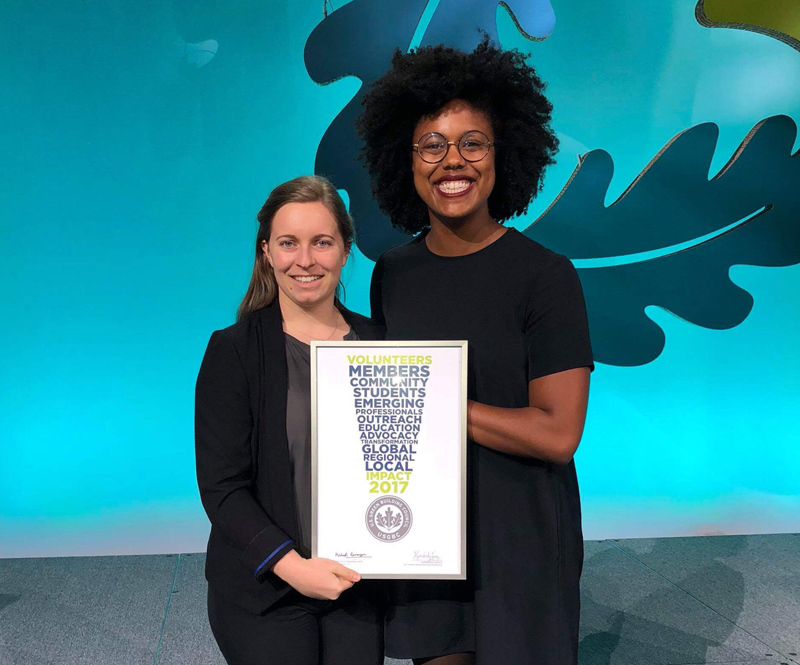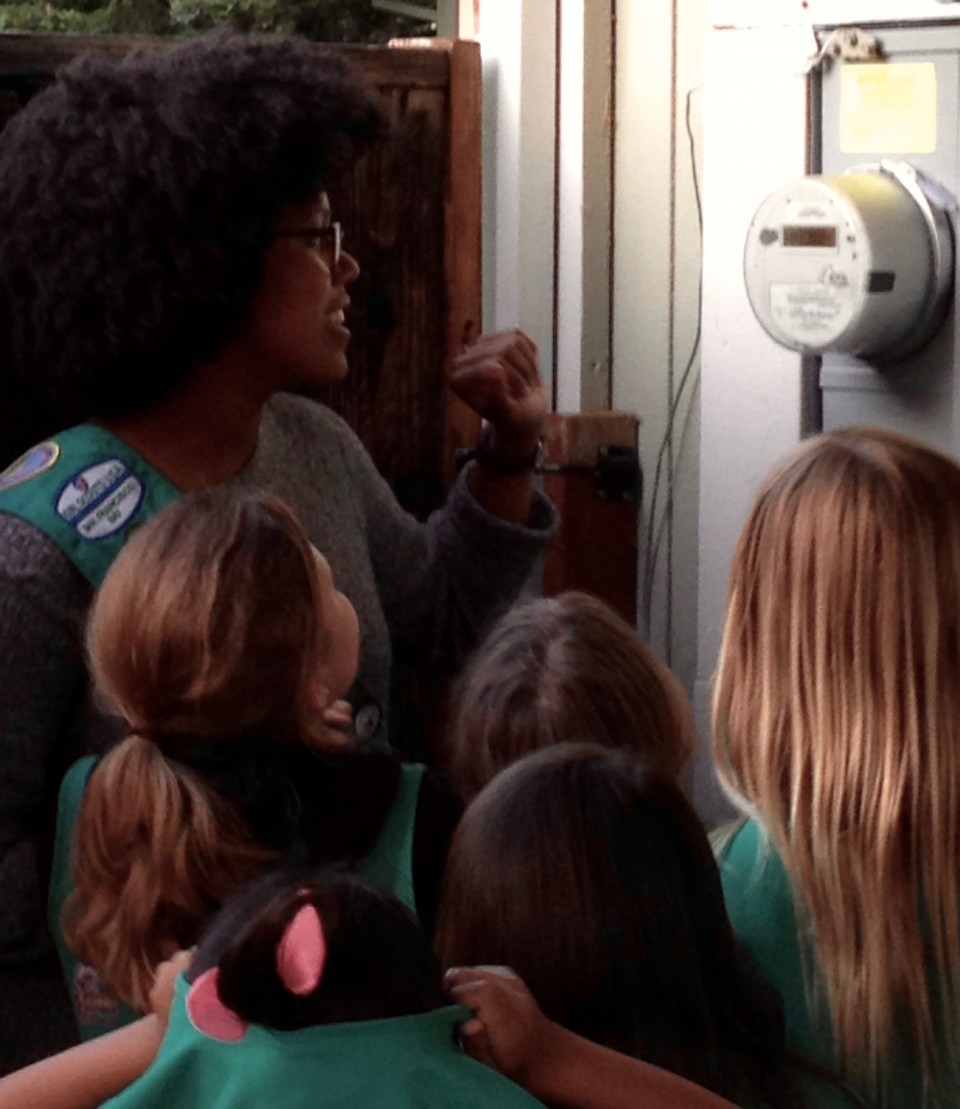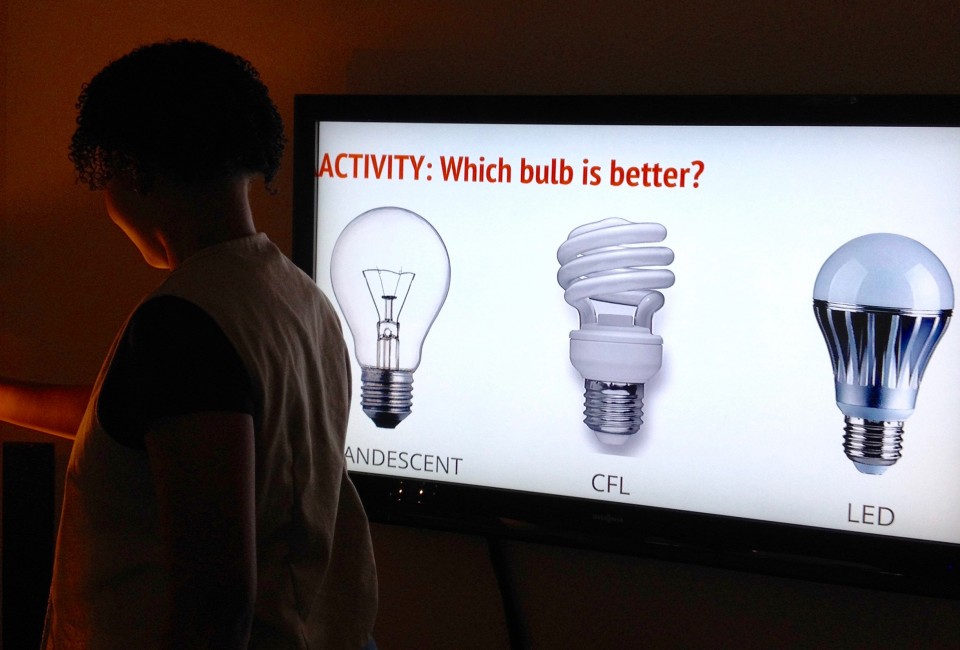Stanford
Adrienne Johnson Receives 2017 USGBC Leadership Award
On 15, Dec 2017 | In PEI Blog | By Larry

Adrienne Johnson (right) and fellow project manager Morgan Abbett at the 2017 GreenBuild Leadership Awards ceremony
Adrienne Johnson, a Sustainability and Innovation Project Engineer at PEI, is a recipient of the prestigious 2017 Leadership Awards, presented by the U.S. Green Building Council (USGBC). The awards are an annual recognition of the outstanding individuals and organizations at the forefront of the green building movement.
“Adrienne has proven her dedication to ensuring that healthy green buildings are accessible to all people, especially our most vulnerable populations, and it is only fitting that we honor her with this well-deserved recognition,” said Mahesh Ramanujam, President and CEO of USGBC and GBCI. She “has shown superb leadership in her community as an advocate for the green building movement and has inspired all of us to continue the charge forward in creating sustainable, healthy and connected communities through the built environment.”
Adrienne was a project manager for the Parkwood Tech Centre (PTC) Project, which is this year’s recipient of the Malcolm Lewis IMPACT! Award. A partnership between an all-female team of Stanford engineers and the South African education nonprofit, Bottomup, the PTC started as a way for the disadvantaged population in the Parkwood community of Cape Town, South Africa, to access computers and educational courses, especially for children. Adrienne helped lead the team who designed, fundraised for, and rebuilt the crumbling and unhealthy existing building. The new Parkwood Tech Centre not only connects the Parkwood community to new opportunities, it is a Net Positive Energy building that generates enough electricity to power all of Parkwood Primary School. The award included an $8,000 prize — the largest sum in its history — that will go directly to funding laptops and other technology infrastructure needs at the new center.
“It is an honor to work with Adrienne,” said CEO and Founder of Point Energy Innovations, Peter Rumsey. “I knew Malcolm when he was alive, and he was a champion of improving people’s lives through sustainable use of energy and design of buildings. Building a net positive energy technology education center for disadvantaged kids in South Africa is exactly what would have made Malcolm jump for joy.”
The award recipients were honored at the 2017 USGBC Leadership Awards Luncheon at the Greenbuild International Conference & Expo on November 9, 2017 in Boston.
The U.S. Green Building Council is committed to a prosperous and sustainable future through cost-efficient and energy-saving green buildings. USGBC works toward its mission of market transformation through its LEED green building program, robust educational offerings, an international network of local community leaders, the annual Greenbuild International Conference & Expo, the Center for Green Schools and advocacy in support of public policy that encourages and enables green buildings and communities. For more information, visit usgbc.org and connect on Twitter, Facebook and LinkedIn.
STEM After Stanford
On 26, Aug 2016 | In PEI Blog | By Molly
By Molly Miller

When she was growing up in suburban Pleasant Hill, Calif., Adrienne Johnson knew she liked science and math, but she had no idea she could become an engineer. “I didn’t know what an engineer was until I got to college,” she says.
Now, having just completed her master’s in civil engineering with an emphasis on sustainable design and construction at Stanford, she is finishing up a summer engineering internship at Point Energy Innovations, a leader in zero energy building design in the Bay Area. She’s ready to launch a career as an engineer, and she’s dedicated to volunteering to advance STEM education (Science, Technology and Math).
At Stanford, she was often the only black woman in her engineering classes. “Until last year, I’d rarely seen anyone like me in any of my classes,” she says. “In most things I do I am thinking about how I can be an example for other young women or young people of color in STEM. That quote ‘you can’t be what you can’t see’ really rings true to me.”
Recently, she was invited back to Pleasant Hill to address a Girl Scout troop at the home of Maria Berta, a scout leader and one of the founders of Point Energy Innovations. A former Pleasant Hill Girl Scout herself, Adrienne talked to the troop about what an engineer does, doing her best to help make science fun. During the meeting, she led the young scouts through an exercise where they could literally feel the energy losses in incandescent bulbs versus LED and compact fluorescent bulbs.
Here is an excerpt from a conversation we had on the pressures and joys of being a role model for young women of color and, she adds, for burgeoning nerds.
How did you become interested in pursuing a career in science?
One of the most influential early experiences I had with STEM was when my Girl Scout troop got to spend the night at Lawrence Hall of Science in Berkeley. I also went to San Francisco’s Exploratorium on a school field trip. That totally blew my mind. It was my favorite field trip. Every time they said we were going on another field trip at school I thought, I hope we are going to the Exploratorium! I still remember those experiences and that is kind of why I studied math and science and eventually became an engineer…because I saw that science could be fun.
Were you surprised the girl scouts were so engaged when you talked with them about energy use? (A young scout named Arianna explained confidently that LED stands for Light Emitting Diode, and Caitlin explained how practical solar energy is. “No one could ever dry up the sun,” she said.)
I was surprised and delighted by how knowledgeable and aware the girls were. I’m excited about where public education is now, at least in Pleasant Hill. It seems to be a lot better than when I was young and they are getting exposed to science at a younger age.
I was also surprised by the ethnic diversity of Pleasant Hill’s Girls Scout Troop. When I was growing up there, I was one of only two or three black kids in my grade in elementary school.

Why is STEM education something you are interested in?
I took a class at Stanford called Expanding Engineering Limits: Culture, Gender and Diversity. We were trying to apply the concepts of Design Thinking to creating better outcomes for students and professionals in STEM. My group was interested in exposing kids to engineering at a young age, so we focused on K-6.
It’s hard to teach kids that young engineering. We knew that informal experiences—like the ones I had at the Exploratorium and Lawrence Hall — could be influential for kids that age. Our idea became having a mobile engineering museum. We wanted to focus on access, so the mobile museum actually went into schools since some schools don’t have the resources to go to places like the Exploratorium.
I took this class because I am a black woman engineer and there are very, very few of us. While pursuing my bachelor’s at Stanford I was the only black person in my engineering program, though it was about one-third women. Stanford’s student body is relatively diverse, compared to Pleasant Hill, but the faculty is 73% white and 73% male. There’s a movement at Stanford called Who’s Teaching Us? working to get Stanford to rethink hiring practices to make sure they are not closing off opportunities to other groups of people.
Do you mind that you have to represent for your race and gender in engineering?
In professional settings, I know that I am often the only representative for my race and my gender. The fear of confirming stereotypes about people like me in STEM adds some pressure.
In my professional experience I hope that I am just evaluated on my merits. But I don’t mind, especially in more informal and volunteer situations, being a role model because I would have liked to have had more, and it’s fun for me…. Social justice and equity are things I am passionate about already, and I am learning that I can use my knowledge in STEM to also address that passion.
What’s next for you?
I’ve accepted a position as an engineer at Point Energy Innovations. But first, I’ll be working as a construction manager on a volunteer project in Cape Town, South Africa. In collaboration with leaders in the community of Parkwood, a team of other Stanford women engineers, and Seattle-based Construction for Change, we will be building the Parkwood Technology Centre later this year.
What’s going to be different for the Girl Scouts of Pleasant Hill when they are where you are, say in 10 years?
I do hope they don’t have to feel that kind of pressure and I hope they will have more role models like myself or their teachers or other people they meet through formal and informal experiences with STEM. It already probably has been better for them. I am hopeful.
But I was a little disturbed by how negatively everyone felt toward the label ‘nerd.’ “I want them to know: It’s ok to be a nerd!”
Editor’s Note: You can learn more about the Parkwood Technology Centre in Cape Town and support the project here.
Where Tech Meets Real Estate: Perspective on an Internship at Point Energy Innovations
On 15, Sep 2015 | In PEI Blog | By Angad
By Angad Deep Singh

“Reimagining all things energy” embodies the vision I had when I decided to enter Stanford to pursue a Masters in Sustainable Design and Construction. While many of my fellow students were pursuing careers in tech, I hoped to take some of the innovative thinking the tech industry is known for and apply it to the slower moving world of real estate.
My Professor Peter Rumsey’s passion for applying unconventional thinking and innovative processes to achieve sustainability excited me more than anything else I’d heard at Stanford, so I decided to apply for an internship at his firm, Point Energy Innovations (PEI). It was an exciting ten weeks of learning, challenging every conventional design process and striving for continuous improvement in every aspect of design. Beyond energy and performance, I learned the importance of considering the legacy of a design on building inhabitants and how we can apply strategies from the fast moving tech sector to achieve remarkably superior buildings.
Point Energy gave me the opportunity to experience the sought after “startup life.” Agile and nimble in its approach, like most startups in the Silicon Valley, PEI allowed me to experience working in the “garage,” where Point Energy is headquartered. I was immediately struck by the energy and passion of the team in executing unconventional design. My first task was to analyze the need for insulating pipes carrying chilled water buried at a depth of two meters below the ground. We were concerned about the water gaining temperature as it flows from the cooling tower to the chillers.
Looking at soil characteristics (constitution, corrosive nature, heat transfer capability etc.) and rate of flow of water, we determined that even without insulation there wasn’t significant temperature gain but the corrosive nature required us to protect steel from coming in contact with the soil. Hence we decided to forgo insulation but coat the pipes with epoxy. In standard design, all buried pipes are automatically insulated. However, this is not always the best way to engineer a system. In this case, burying uninsulated pipes provided significant cost savings without impacting the performance of the system. This exercise provided me with the important insight that questioning rules of thumb in building design could save energy and materials and improve the quality of our buildings.
The built environment is one of the biggest contributors to the energy demand of any economy and hence also provides some of the largest opportunities for improving the energy efficiency. Creating highly insulated building envelopes with integrated passive design features such as maximizing daylight while minimizing direct sunlight and insulation for reducing power consumption for heating, cooling and ventilation ensures that the energy usage of the building is minimized while the needs and comfort of the building occupants are not compromised. These are essential features of every building that PEI designs. But there’s another unique concept that is an integral part of the design process at PEI. They call it “humanizing” building design.
Humanizing Building Design still remains an obscure concept to most building designers. I was able to comprehend the thought process behind this simple, yet extremely powerful phrase when I worked on designing a Net Zero Energy middle school in Hillsborough, California. All classrooms in the building are naturally ventilated and cooled using outside air, with no mechanical cooling equipment. We implemented the strategy not only to reduce the energy consumption of the building but also to create a sense of ownership of the environment among the children in the school.
Incorporating the concept of environmental stewardship for the upcoming generation means that we help shape responsible citizens while at the same time making a school that uses minimal energy and boosts productivity of students. “Simplicity” and “inclusivity” are an essential and integral part of this concept. At each step of the design, we ensured that each stakeholder (occupants, maintenance staff, contractor, etc.) interacting with the building understood the intention behind our design and the purpose of the design, which would ensure that each aspect of the design is operated correctly maximizing results and achieving our target of creating an extremely comfortable yet low energy building.
Another obscure concept in building design, where “rules of thumb” and manufacturer claims still form the basis of design, is the practice of prototyping. Prototyping is a well-understood term in the technology industry, where various versions of the product are released and tested before the final product is released for use by the end consumer. A classic example of this is roof-top photovoltaic modules, wherein the design team often determines the number of modules to install based on the manufacturer’s efficiency claims. At PEI we were not satisfied with going purely by claims of the manufacturer and decided to adopt the “prototyping” approach. While designing buildings for a large well-known technology company in Silicon Valley that included building integrated photovoltaic modules, PEI decided to set-up a field experiment to determine the average efficiency of the module, while also determining how various environmental factors impacted the module efficiency. The results will allow building designers to more accurately predict the number of modules needed, resulting in better building design.
Although, the construction industry remains a traditional space with little acceptance of newer ways of doing things or outlandish ideas, it provides an excellent avenue for innovators and ideators to revolutionize an industry that creates the very buildings we spend most of our time in. It was great to learn firsthand how Peter Rumsey along with the small but extremely passionate PEI team are acting as this essential catalyst of change.

